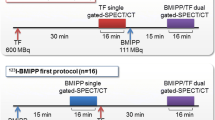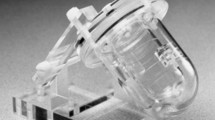Abstract
Background
We studied the impact of technetium-99m (99mTc) in the thallium-201 (201Tl) energy window (70 keV) to determine if CZT cardiac cameras allow us to perform simultaneous dual-isotope acquisition for myocardial perfusion imaging.
Methods
We included 117 consecutive patients. We injected 0.7 MBq/kg of 201Tl at stress, performed the first scan (image T1), then injected at rest 2 MBq/kg of 99mTc-tetrofosmin and immediately acquired a second scan with reconstruction in the energy window of thallium (image T2). A corrected thallium image was created by the subtraction of 99mTc downscattered photons (image TS). We compared spectra, image quality, and semiquantitative scores on T1, T2, and TS images.
Results
Though T2 images were of worse quality, TS images were of equal quality compared to T1 images in most cases. Scores show an underestimation of abnormalities in 20% of patients on T2 images and in 10% on TS images.
Conclusions
Despite the improved energy resolution of CZT cameras, downscatter of technetium in the 201Tl window leads to an underestimation of the pathological territory in 10% to 20% of cases. It does not allow us to use simultaneous dual-isotope acquisition in clinical practice without additional tools for scatter correction.









Similar content being viewed by others
Abbreviations
- CZT:
-
Cadmium-Zinc-Telluride
- MPI:
-
Myocardial perfusion imaging
- CAD:
-
Coronary artery disease
- SSS:
-
Summed Stress Score
- BMI:
-
Body Mass Index
- ASNC:
-
American Society of Nuclear Cardiology
- SPECT:
-
Single Photon Emission Computed Tomography
- MBq:
-
Megabecquerels
- mCi:
-
Millicuries
- mSv:
-
Millisievert
References
Montalescot G, Sechtem U, Achenbach S, Andreotti F, Arden C, Budaj A, et al. 2013 ESC guidelines on the management of stable coronary artery disease. Eur Heart J 2013;34:2949-3003.
Berrington de Gonzalez A, Kim KP, Smith-Bindman R, McAreavey D. Myocardial perfusion scans: Projected population cancer risks from current levels of use in the United States. Circulation 2010;122:2403-10.
Einstein AJ, Weiner SD, Bernheim A, Kulon M, Bokhari S, Johnson LL, et al. Multiple testing, cumulative radiation dose, and clinical indications in patients undergoing myocardial perfusion imaging. JAMA 2010;304:2137-44.
Sharir T, Ben-Haim S, Merzon K, Prochorov V, Dickman D, Ben-Haim S, et al. High-speed myocardial perfusion imaging initial clinical comparison with conventional dual detector anger camera imaging. JACC Cardiovasc Imaging 2008;1:156-63.
Gambhir SS, Berman DS, Ziffer J, Nagler M, Sandler M, Patton J, et al. A novel high-sensitivity rapid-acquisition single-photon cardiac imaging camera. J Nucl Med 2009;50:635-43.
Esteves FP, Raggi P, Folks RD, Keidar Z, Askew JW, Rispler S, et al. Novel solid-state-detector dedicated cardiac camera for fast myocardial perfusion imaging: Multicenter comparison with standard dual detector cameras. J Nucl Cardiol 2009;16:927-34.
Imbert L, Poussier S, Franken PR, Songy B, Verger A, Morel O, et al. Compared performance of high-sensitivity cameras dedicated to myocardial perfusion SPECT: A comprehensive analysis of phantom and human images. J Nucl Med 2012;53:1897-903.
Songy B, Guernou M, Lussato D, Queneau M, Geronazzo R. Low-dose thallium-201 protocol with a cadmium-zinc-telluride cardiac camera. Nucl Med Commun 2012;33:4649.
Songy B, Guernou M, Hivoux D, Attias D, Lussato D, Queneau M, et al. Prognostic value of one millisievert exercise myocardial perfusion imaging in patients without known coronary artery disease. J Nucl Cardiol 2018;25:120-30.
Agostini D, Marie PY, Ben-Haim S, Rouzet F, Songy B, Giordano A, et al. Performance of cardiac cadmium-zinc-telluride gamma camera imaging in coronary artery disease: A review from the cardiovascular committee of the European Association of Nuclear Medicine (EANM). Eur J Nucl Med Mol Imaging 2016;43:2423-32.
Cerqueira MD, Weissman NJ, Dilsizian V, Jacobs AK, Kaul S, Laskey WK, et al. Standardized myocardial segmentation and nomenclature for tomographic imaging of the heart. A statement for healthcare professionals from the Cardiac Imaging Committee of the Council on Clinical Cardiology of the American Heart Association. J Nucl Cardiol 2002;9:240-5.
Einstein AJ, Blankstein R, Andrews H, Fish M, Padgett R, Hayes SW, et al. Comparison of image quality, myocardial perfusion, and left ventricular function between standard imaging and single-injection ultra-low-dose imaging using a high-efficiency SPECT camera: The MILLISIEVERT study. J Nucl Med 2014;55:1430-7.
Dey T, Backus BE, Romijn RL, Wieczorek H, Verzijlbergen JF. Low-dose single acquisition rest (99m)Tc/stress (201)Tl myocardial perfusion SPECT protocol: Phantom studies and clinical validation. Eur J Nucl Med Mol Imaging 2014;41:536-47.
Cerqueira M, Allmann K, Ficaro E, Hansen CL, Nichols KJ, Thompson RC, et al. Recommendations for reducing radiation exposure in myocardial perfusion imaging. J Nucl Cardiol 2010;17:709-18.
Grunwald AM, Watson DD, Holzgrefe HH Jr, Irving JF, Beller GA. Myocardial thallium-201 kinetics in normal and ischemic myocardium. Circulation 1981;64:610-8.
Hesse B, Tägil K, Cuocolo A, Anagnostopoulos C, Bardiés M, Bax J, et al. EANM/ESC procedural guidelines for myocardial perfusion imaging in nuclear cardiology. Eur J Nucl Med Mol Imaging 2005;32:855-97.
Henzlova MJ, Duvall WL. Return of dual-isotope SPECT myocardial perfusion imaging? Not so fast…. J Nucl Cardiol 2015;22:523-5.
Thomas SR, Stabin MG, Castronovo FP. Radiation-absorbed dose from 201Tl-thallous chloride. J Nucl Med 2005;46:502-8.
Ben-Haim S, Kacperski K, Hain S, Van Gramberg D, Hutton BF, Erlandsson K, et al. Simultaneous dual-radionuclide myocardial perfusion imaging with a solid-state dedicated cardiac camera. Eur J Nucl Med Mol Imaging 2010;37:1710-21.
Berman DS, Kiat H, Friedman JD, Wang FP, van Train K, Matzer L, et al. Separate acquisition rest thallium-201/stress technetium-99m sestamibi dual-isotope myocardial perfusion single-photon emission computed tomography: A clinical validation study. J Am Coll Cardiol 1993;22:1455-64.
Weinmann P, Foult JM, Le Guludec D, Tamgac F, Rechtman D, Neuman A, et al. Dual-isotope myocardial imaging: Feasibility, advantages and limitations. Preliminary report on 231 consecutive patients. Eur J Nucl Med 1994;21:212-5.
Berman DS, Kang X, Tamarappoo B, Wolak A, Hayes SW, Nakazato R, et al. Stress thallium-201/rest technetium-99m sequential dual isotope high-speed myocardial perfusion imaging. JACC Cardiovasc Imaging 2009;2:273-82.
Barone-Rochette G, Leclere M, Calizzano A, Vautrin E, Gallazzini-Crepin C, Broisat A, et al. Stress thallium-201/rest technetium-99m sequential dual-isotope high-speed myocardial perfusion imaging validation versus invasive coronary angiography. J Nucl Cardiol 2015;22:513-22.
Weinmann P, Faraggi M, Moretti JL, Hannequin P. Clinical validation of simultaneous dual-isotope myocardial scintigraphy. Eur J Nucl Med Mol Imaging. 2003;30:25–31.
Imbert L, Roch V, Merlin C, Djaballah W, Cachin F, Perrin M, et al. Low-dose dual-isotope procedure planned for myocardial perfusion CZT-SPECT and assessed through a head-to-head comparison with a conventional single-isotope protocol. J Nucl Cardiol 2017; in press.
Makita A, Matsumoto N, Suzuki Y, Hori Y, Kuronuma K, Yoda S, et al. Clinical feasibility of simultaneous acquisition rest (99m)Tc/stress (201)Tl dual-isotope myocardial perfusion single-photon emission computed tomography with a semiconductor camera. Circ J 2016;80:689-95.
Knesaurek K, Machac J. Three-window transformation cross-talk correction for simultaneous dual-isotope imaging. J Nucl Med 1997;38:1992-8.
Disclosure
There is no financial disclosure.
Author information
Authors and Affiliations
Corresponding author
Additional information
The authors of this article have provided a PowerPoint file, available for download at SpringerLink, which summarizes the contents of the paper and is free for re-use at meetings and presentations. Search for the article DOI on SpringerLink.com.
Electronic supplementary material
Below is the link to the electronic supplementary material.
Rights and permissions
About this article
Cite this article
Songy, B., Guernou, M., Lussato, D. et al. Feasibility of simultaneous dual isotope acquisition for myocardial perfusion imaging with a cadmium zinc telluride camera. J. Nucl. Cardiol. 27, 737–747 (2020). https://doi.org/10.1007/s12350-018-1452-z
Received:
Accepted:
Published:
Issue Date:
DOI: https://doi.org/10.1007/s12350-018-1452-z




